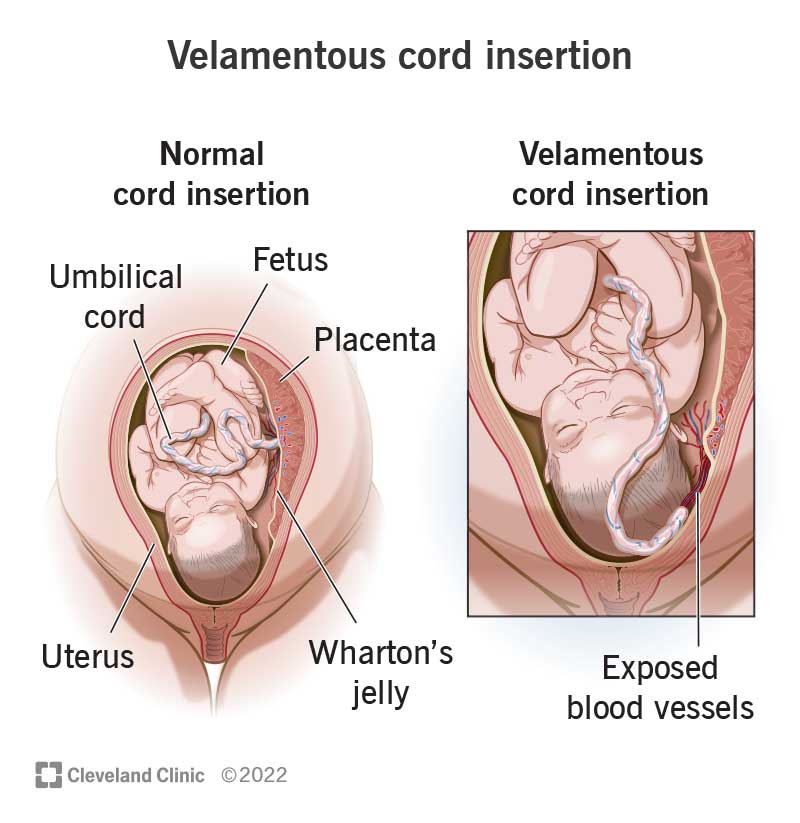Velamentous cord insertion happens when the umbilical cord that connects you and your fetus doesn’t attach to the placenta correctly. It can lead to complications during pregnancy. Your healthcare provider will monitor velamentous cord insertion closely and recommend a plan for your pregnancy to reduce any risks during childbirth.
Advertisement
Cleveland Clinic is a non-profit academic medical center. Advertising on our site helps support our mission. We do not endorse non-Cleveland Clinic products or services. Policy

Velamentous cord insertion is a pregnancy complication that happens when the umbilical cord from a fetus doesn’t insert into the placenta correctly. The placenta is an organ in your uterus (womb) that forms during pregnancy. It allows your body to share nutrients with the fetus. The umbilical cord connects the fetus to the placenta so that the sharing can happen.
Advertisement
Cleveland Clinic is a non-profit academic medical center. Advertising on our site helps support our mission. We do not endorse non-Cleveland Clinic products or services. Policy
Typically, the umbilical cord travels from a fetus’s belly button to inside the placenta, where there’s easy access to the nutrients you’re sharing. A gel-like substance called Wharton’s jelly protects the blood vessels inside the umbilical cord so that they don’t twist, squeeze or break.
With velamentous cord insertion, the umbilical cord attaches to membranes outside of the placenta instead. This means that the blood vessels from the umbilical cord have to travel much farther to get nutrients from the placenta. And they have to travel without the protection of Wharton’s jelly. Without easy access to the placenta’s nutrients, a fetus may develop more slowly. Without the cushioning from Wharton’s jelly, the exposed blood vessels from the umbilical cord are more likely to burst and bleed.
Velamentous cord insertions are rare. Only about 1% of single-birth pregnancies (one baby) and 6% of multiple births (twins) involve velamentous cord insertion. The rate increases to about 15% for twins who share the same placenta (MCDA twins).
No one knows for sure what causes velamentous cord insertion. But they tend to show up more often in certain pregnancies. Understanding when they’re more likely to happen can make it easier for you and your healthcare provider to take all necessary precautions to keep you and the fetus safe during pregnancy.
Advertisement
Yes. Velamentous cord insertion can slow a fetus’s development. Without the protection of Wharton’s jelly, the blood vessels in the umbilical cord are more likely to break and bleed. These risks may affect your pregnancy and your baby.
With velamentous cord insertion there’s an increased risk of:
Your baby may:
About 6% of pregnancies with velamentous cord insertion also have a condition called vasa previa. With vasa previa, the umbilical cord attaches to membranes that are close to your cervix. During labor, the exposed blood vessels run an especially high risk of bursting when the fetus starts putting pressure on your cervix. Both you and the fetus run the risk of heavy bleeding. About half of these pregnancies end with stillbirth.
Getting diagnosed early can prevent this from happening. If your healthcare provider sees exposed blood vessels from the umbilical cord near your cervix, they’ll likely suggest a C-section. The outcomes associated with vasa previa improve greatly with a C-section. The survival rate for the fetus goes up to 97% to 99%.
Vaginal bleeding — especially in your third trimester — can be a sign of velamentous cord insertion. Or, you may not notice any symptoms at all. Instead, your healthcare provider will likely be able to diagnose velamentous cord insertion through imaging and by monitoring the fetus. The fetus may have:
By your second trimester, your healthcare provider should be able use an ultrasound to see where the umbilical cord has inserted. A color Doppler ultrasound provides an even clearer picture. By your third trimester, when the fetus has grown much bigger, it may be harder for your provider to see the umbilical cord and make a diagnosis.
Advertisement
There’s no way to treat velamentous cord insertion. Instead, your healthcare provider will take extra precautions to reduce any risks. Your provider may:
Your provider will take extra care to monitor your pregnancy so that you’re able to deliver your baby safely. This may mean regular ultrasounds and non-stress tests. It may mean that you deliver your baby via a C-section or vaginally. Your provider may recommend that you deliver around your due date or several weeks before. It may mean that your baby needs additional care in the neonatal ICU unit once it arrives.
Advertisement
Your healthcare provider is the best resource to advise you on the most appropriate plan for your pregnancy and what to expect in the days leading up to delivery and after your baby is born.
You can’t prevent velamentous cord insertion, but your chances of experiencing one are extremely low. If you’ve been diagnosed with velamentous cord insertion, this means that your healthcare provider knows to monitor your pregnancy closely for any complications. Early diagnosis and close monitoring make all the difference when it comes to having a healthy pregnancy.
Speak with your healthcare provider to understand what velamentous cord insertion means for your pregnancy. The treatment you receive will depend on your unique case. Follow your provider’s instructions for how to best care for yourself each day. Questions to ask include:
Learning about the complications that can happen with velamentous cord insertion can be scary. But complications are rare. You may need closer monitoring both during your pregnancy and during labor, but this extra care improves the outcomes in velamentous cord insertion pregnancies. Speak to your healthcare provider about how your velamentous cord insertion will influence your pregnancy plan.
Advertisement
Worried about your high-risk pregnancy? Want the best maternal and fetal health care? Look no further than Cleveland Clinic. We’re here for all your needs.

Last reviewed on 09/06/2022.
Learn more about the Health Library and our editorial process.